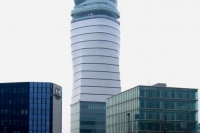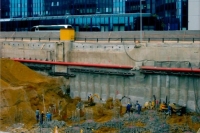Vienna International Airport,
Air Traffic Control Center and Tower
Client: Vienna Airport AG
Development Period: 2002 to 2005
At height of 109 m and situated west of the World Trade Center, the control tower became the new landmark of the Vienna International Airport. The control tower includes an integrated office building housing the Austrian air traffic control (Austro Control GesmbH). Since its completion in 2005, the new tower represents the technical heart of the air traffic control in Vienna.
In order to minimize settlements, the tower was constructed with a combined pile-plate foundation. To accomplish this, 34 bored piles (Ø 1.2 m) with a depth of up to 35 m below surface were first of all manufactured. Secondly, on top of them, a reinforced concrete plate with a thickness of 2.5 m was placed.
The building pit had a depth of up to 12 m.
For this project, BGG Consult was commissioned with the geotechnical and hydrogeological consulting during all design and building phases. In order to gather essential information regarding the underground, a subsoil exploration campaign was coordinated and executed. Based on the results of this investigation, geotechnical expert's reports were compiled that were required for the application of the building permit, the preparation of the tender, and the planning of the construction.
During construction, geotechnical assessments and evaluations were conducted on site.
Bored piles:
In the underground of the construction site, alternating sequences of sand and silt exist in the tertiary sediments, resulting in confined groundwater systems. During manufacturing of the bored piles, special attention had to be given to this situation. In order to avoid massive uplift of sand, the drilling had to be carried out under a water load. Thanks to the thorough geotechnical evaluation, this necessity was already identified during the tender planning phase and could therefore be implemented without requiring additional expenses.
Securing of the building pit:
At two sides of the building a control channel exists that is highly susceptible to displacements. In order to minimize possible displacements, anchored bored piles were used for the slope of the pit and concrete girders, with a force-fit connection to the channel wall, were inserted. Thus, the displacements remained below the specified limits.
April 2006

